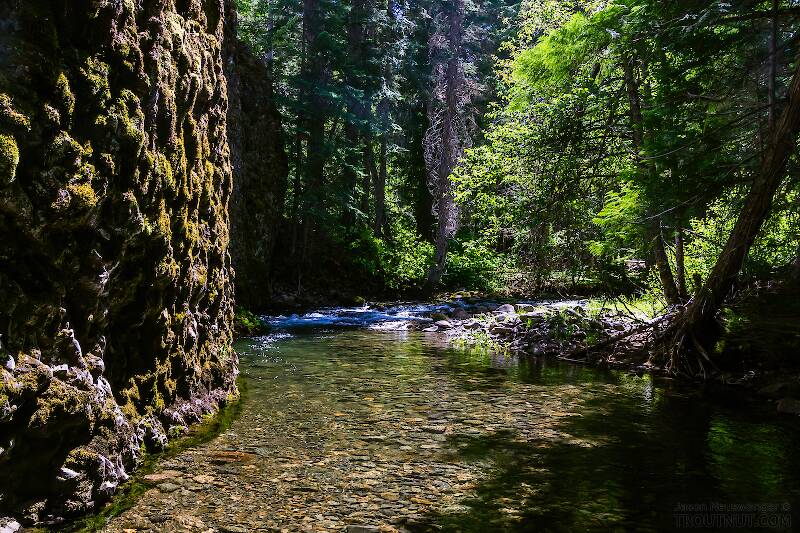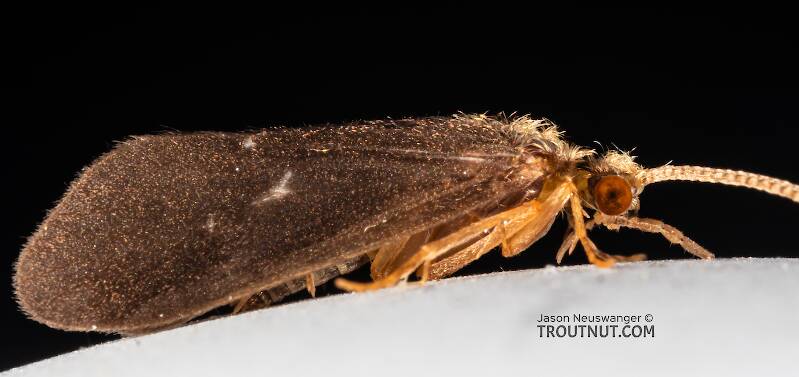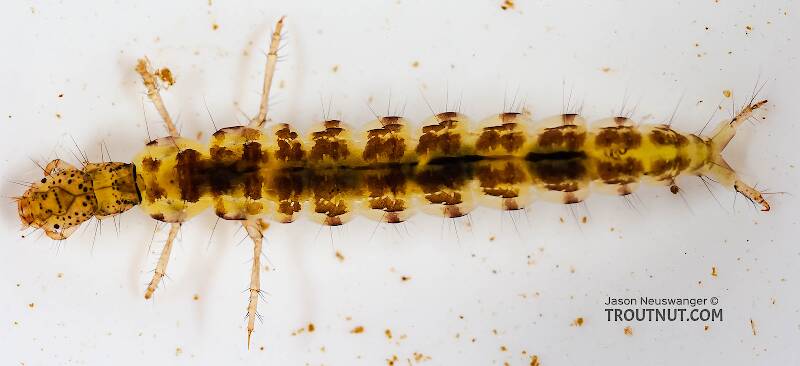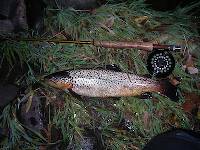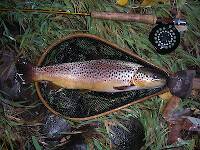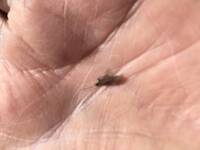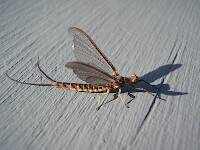
Blue-winged Olives
Baetis
Tiny Baetis mayflies are perhaps the most commonly encountered and imitated by anglers on all American trout streams due to their great abundance, widespread distribution, and trout-friendly emergence habits.
Featured on the forum

This specimen keys pretty easily to Onocosmoecus, and it closely resembles a specimen from Alaska which caddis expert Dave Ruiter recognized as this genus. As with that specimen, the only species in the genus documented in this area is Onocosmoecus unicolor, but Dave suggested for that specimen that there might be multiple not-yet-distinguished species under the unicolor umbrella and it would be best to stick with the genus-level ID. I'm doing the same for this one.

Troutnut is a project started in 2003 by salmonid ecologist Jason "Troutnut" Neuswanger to help anglers and
fly tyers unabashedly embrace the entomological side of the sport. Learn more about Troutnut or
support the project for an enhanced experience here.
This topic is about the Caddisfly Family Polycentropodidae
These small caddisflies are of occasional importance, but the family doesn't include any major superhatches.Example specimens
LowBudget on Oct 1, 2013October 1st, 2013, 4:22 pm EDT
The first image is of a live caddis. It was collected from Trout Creek which is in the Delaware River watershed in upstate NY. The background is 1/4 inch ruled graph paper which is under the Petrie dish holding the caddis with water.

The second shows small silk nets found on rocks in the same stream during the same sampling.

I've been working all of my ID books including "Freshwater Macroinvertebrates of Northeastern North America" by Peckarsky.
The upper lip does not seem to have the T shape of a Fingernet caddis. It does have the heavy mandible with a brush of Polycentropodidae.
But, I'm not completely satisfied.
Anyone have thoughts on this?
Ed

The second shows small silk nets found on rocks in the same stream during the same sampling.

I've been working all of my ID books including "Freshwater Macroinvertebrates of Northeastern North America" by Peckarsky.
The upper lip does not seem to have the T shape of a Fingernet caddis. It does have the heavy mandible with a brush of Polycentropodidae.
But, I'm not completely satisfied.
Anyone have thoughts on this?
Ed
Ed
Low Budget Fly Tying and Fishing author of "Behind the Fly"
http://edengelman.com/BTF.html
Low Budget Fly Tying and Fishing author of "Behind the Fly"
http://edengelman.com/BTF.html
Crepuscular on Oct 2, 2013October 2nd, 2013, 10:33 am EDT
I'd call that Philopotamidae. No muscle scars on the head. Also the T-shaped labrum is often withdrawn, and not always visble. It is hard to see from the photo but it looks like the frontoclypeal apotome might be notched which would make it Chimarra sp..
Creno, anyone else, What do you think?
Creno, anyone else, What do you think?
Creno on Oct 2, 2013October 2nd, 2013, 1:18 pm EDT
Ed - I cannot be sure from the pic but the long/narrow head makes me think philopotamid. If you have the animal and a scope you should be able to figure it out for sure.
Did you actually catch caddis from those cases on the rocks, or midges? What was the size of the cases?
Did you actually catch caddis from those cases on the rocks, or midges? What was the size of the cases?
Crepuscular on Oct 2, 2013October 2nd, 2013, 3:28 pm EDT
I think I can see at least one midge poking his head out of one of those cases. Right in the middle of the photo.
But like you said Dave,
So my speculation of Chimarra is just that, speculation.
But like you said Dave,
I have found it is easy to make determinations when you can see the parts clearly :-)
So my speculation of Chimarra is just that, speculation.
Entoman on Oct 2, 2013October 2nd, 2013, 4:41 pm EDT
Welcome to the forum, Ed! If you still have the specimen, try for some dorsal closeups of the anterior head capsule. It would be better if the bias is anterior (taken from a front angle) to match the slope of the head. A good lateral of the fore-leg area to catch the trochantin and a lateral of the anal prolegs would be helpful as well. We should be able to clear things up for you on the family and probably take it to the genus level - perhaps even species if we're lucky. If you can't, I'd be happy to tell you what to look for.
Don't know what to make of those cases.
It's probably a philopotamid (finger-net caddis) but I can't see enough to rule out Polycentropodidae (Trumpet-net caddis) entirely, though. Head spots are on the most common but it is my understanding that not all have them.
Eric -
I agree that something is going on there. Assuming it to be a philopotamid, Wormaldia (Little Autumn Sedge) is rounded but Dolophilodes distinctus (Winter Caddis) is also notched, though less radically (more of a wave than the spiked graph chart or deep "V" of Chimarra). Like you, I just can't make out the frontoclyptus well enough to tell one way or the other. For what it's worth, the dark edge between the pronotum and the meso is a better match for what I've seen on winter caddis larvae. On Chimarra specimens, I've noticed they are much more convex.
Don't know what to make of those cases.
It's probably a philopotamid (finger-net caddis) but I can't see enough to rule out Polycentropodidae (Trumpet-net caddis) entirely, though. Head spots are on the most common but it is my understanding that not all have them.
Eric -
It is hard to see from the photo but it looks like the frontoclypeal apotome might be notched which would make it Chimarra sp..
I agree that something is going on there. Assuming it to be a philopotamid, Wormaldia (Little Autumn Sedge) is rounded but Dolophilodes distinctus (Winter Caddis) is also notched, though less radically (more of a wave than the spiked graph chart or deep "V" of Chimarra). Like you, I just can't make out the frontoclyptus well enough to tell one way or the other. For what it's worth, the dark edge between the pronotum and the meso is a better match for what I've seen on winter caddis larvae. On Chimarra specimens, I've noticed they are much more convex.
"It's not that I find fishing so important, it's just that I find all other endeavors of Man equally unimportant... And not nearly as much fun!" Robert Traver, Anatomy of a Fisherman
LowBudget on Oct 3, 2013October 3rd, 2013, 3:25 am EDT
Thank you for your responses.
I still have the sample in an aquarium. I will try to take some additional images today.
I wish I had included a scale in the image of the cases. I believe that the cases were about 1/2 inches long. I did not see any insects in these cases. We were doing a rock pick in addition to our dip net sampling.
I performed the sampling according to WAVE protocols. Wadeable Assessments by Volunteer Evaluators (WAVE) is a citizen-based water quality assessment developed by the NYS Department of Environmental Conservation (NYSDEC). This is the first year that the program has included the New York portion of the Delaware River watershed. For more information:
http://www.dec.ny.gov/chemical/92229.html
Ed
I still have the sample in an aquarium. I will try to take some additional images today.
I wish I had included a scale in the image of the cases. I believe that the cases were about 1/2 inches long. I did not see any insects in these cases. We were doing a rock pick in addition to our dip net sampling.
I performed the sampling according to WAVE protocols. Wadeable Assessments by Volunteer Evaluators (WAVE) is a citizen-based water quality assessment developed by the NYS Department of Environmental Conservation (NYSDEC). This is the first year that the program has included the New York portion of the Delaware River watershed. For more information:
http://www.dec.ny.gov/chemical/92229.html
Ed
Ed
Low Budget Fly Tying and Fishing author of "Behind the Fly"
http://edengelman.com/BTF.html
Low Budget Fly Tying and Fishing author of "Behind the Fly"
http://edengelman.com/BTF.html
Crepuscular on Oct 3, 2013October 3rd, 2013, 5:14 am EDT
This is the insect that I see the photo of the cases. and it looks like the head capsule of a midge to me.
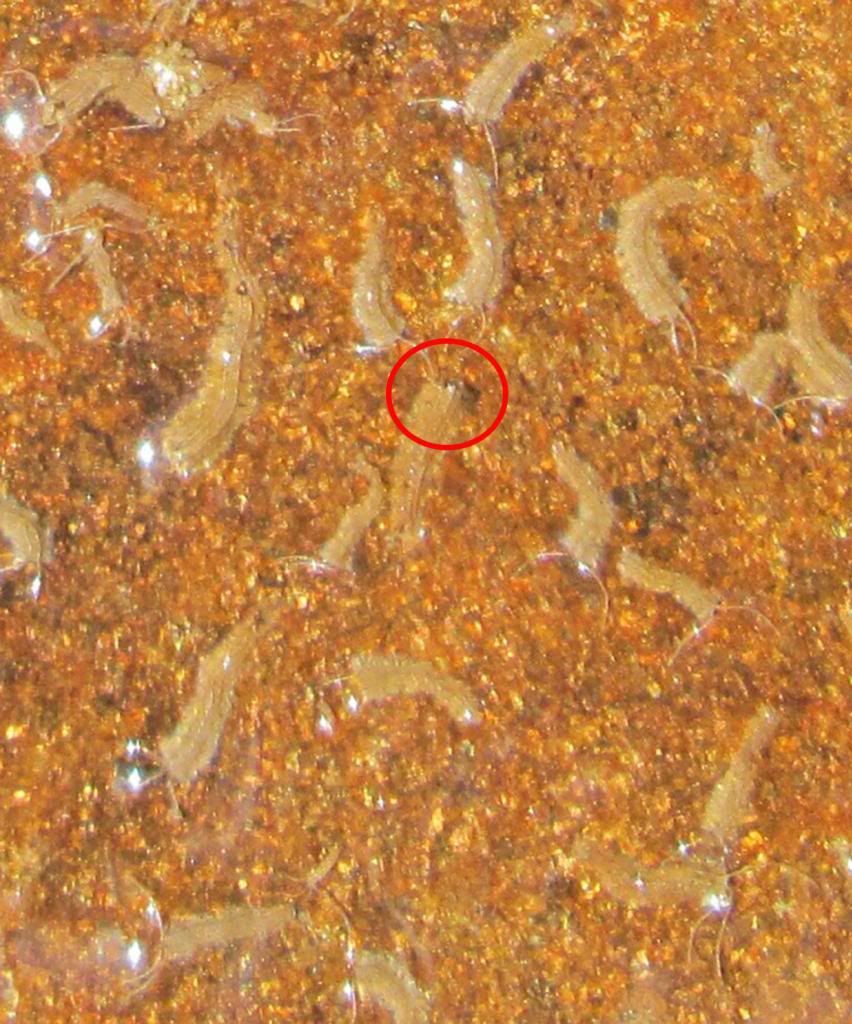
Kurt, yeah like you stated Dolophilodes does have a slight asymmetry but I was kind of thinking that if it was showing up on that photo it may be more of a notch (Chimarra) than the more subtle asymmetry of Dolophilodes which is why I threw that genus out there but it's stupid on my part to speculate.

Kurt, yeah like you stated Dolophilodes does have a slight asymmetry but I was kind of thinking that if it was showing up on that photo it may be more of a notch (Chimarra) than the more subtle asymmetry of Dolophilodes which is why I threw that genus out there but it's stupid on my part to speculate.
Entoman on Oct 3, 2013October 3rd, 2013, 10:17 am EDT
Heck, Eric, many if not most of the determinations on this site start off with "speculation." If we didn't, what would get the ball rolling? :) Case in point is the recent October caddis thread. Speculating that it was gilvepes lead to finding out it was atripes. If I had only posted what I was sure of, I would have just written "Here's a photo of Dicosmoecus." I'd bet a dollar against a doughnut that the discussion would have stopped there. Please, keep on speculating. I sure as heck will!:)
BTW - I knew you were probably aware of the info in my post - didn't mean to imply that you weren't or that I disagreed with your ideas. Quoting can give that impression I guess, but that certainly wasn't my intent. I just wanted to provide the thread with additional info and alternative possibilities to enhance the discussion.
Ed - good luck with the photos!
BTW - I knew you were probably aware of the info in my post - didn't mean to imply that you weren't or that I disagreed with your ideas. Quoting can give that impression I guess, but that certainly wasn't my intent. I just wanted to provide the thread with additional info and alternative possibilities to enhance the discussion.
Ed - good luck with the photos!
"It's not that I find fishing so important, it's just that I find all other endeavors of Man equally unimportant... And not nearly as much fun!" Robert Traver, Anatomy of a Fisherman
Crepuscular on Oct 3, 2013October 3rd, 2013, 10:33 am EDT
BTW - I knew you were probably aware of the info in my post - didn't mean to imply that you weren't or that I disagreed with your ideas. Quoting can give that impression I guess, but that certainly wasn't my intent. I just wanted to provide the thread with additional info and alternative possibilities to enhance the discussion.
I didn't take it that way. No worries!
Entoman on Oct 3, 2013October 3rd, 2013, 10:44 am EDT
Good. BTW - Could this critter be in the wrong place? If so, I'll move it. http://www.troutnut.com/specimen/315
"It's not that I find fishing so important, it's just that I find all other endeavors of Man equally unimportant... And not nearly as much fun!" Robert Traver, Anatomy of a Fisherman
Crepuscular on Oct 3, 2013October 3rd, 2013, 3:06 pm EDT
Good. BTW - Could this critter be in the wrong place? If so, I'll move it. http://www.troutnut.com/specimen/315
I don't think so. It looks like Chimarra to me.
Entoman on Oct 3, 2013October 3rd, 2013, 3:44 pm EDT
Thanks. This one had me rubbing my eyes a little. Every time I looked at it, it seemed to be one or the other.:)
"It's not that I find fishing so important, it's just that I find all other endeavors of Man equally unimportant... And not nearly as much fun!" Robert Traver, Anatomy of a Fisherman
LowBudget on Oct 14, 2013October 14th, 2013, 9:27 am EDT
I've looked through my sample for hours and can't find any more! Apparently they were preyed upon by other species in the sample. I'm blaming the common stonefly larvae.
Unfortunately, I have only limited access to the original sampling site.
I did find one head capsule, but when I went to pick it up with a pipette, it scattered into a bunch of different pieces in the aquarium which has all kinds of detritus.
Thank you all for your expertise.
After viewing the images on this site of Chimarra (Little Black Sedges), I agree that it is indeed a Philopotamidae.
Thank you again
Ed
Unfortunately, I have only limited access to the original sampling site.
I did find one head capsule, but when I went to pick it up with a pipette, it scattered into a bunch of different pieces in the aquarium which has all kinds of detritus.
Thank you all for your expertise.
After viewing the images on this site of Chimarra (Little Black Sedges), I agree that it is indeed a Philopotamidae.
Thank you again
Ed
Ed
Low Budget Fly Tying and Fishing author of "Behind the Fly"
http://edengelman.com/BTF.html
Low Budget Fly Tying and Fishing author of "Behind the Fly"
http://edengelman.com/BTF.html
Beardius
Posts: 19
Posts: 19
Beardius on Jul 24, 2014July 24th, 2014, 8:08 am EDT
The small cases in the second photo are cases for the midge Rheotanytarsus exiguus group sp. One can see the characteristic seams and terminal extensions on several of them. They are very common in most stream systems.
Crepuscular on Jul 24, 2014July 24th, 2014, 8:22 am EDT
The small cases in the second photo are cases for the midge Rheotanytarsus exiguus group sp. One can see the characteristic seams and terminal extensions on several of them. They are very common in most stream systems.
Thanks, I figured they some Chironomid, but wasn't gonna go anywhere past that.
Quick Reply
Related Discussions
Topic
Replies
Last Reply
1
Apr 12, 2007
by GONZO
by GONZO

